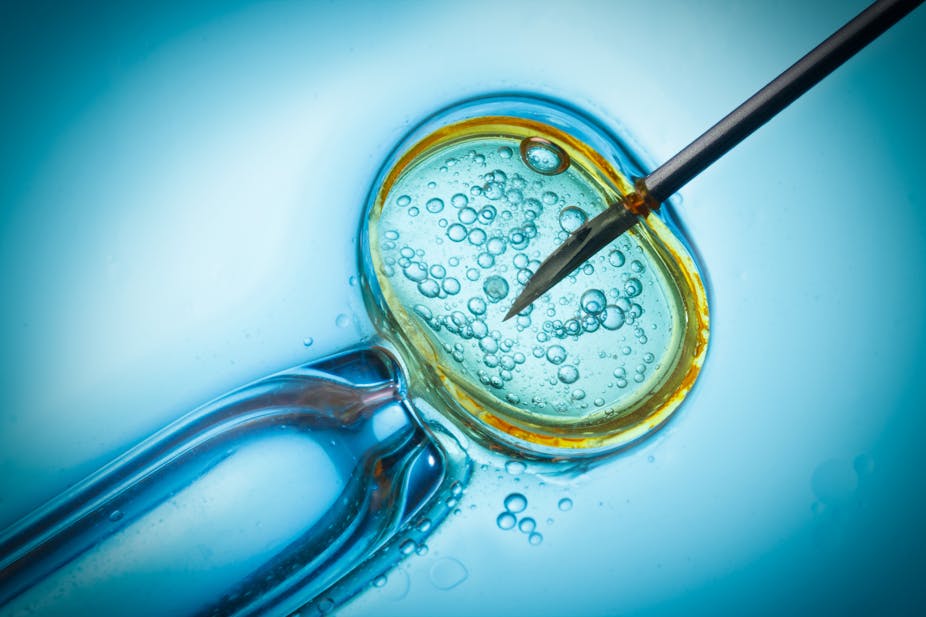The UK parliament will soon consider making Britain the first country to allow three-person IVF. The regulations are yet to be approved, but the government is currently backing moves to allow the creation of babies with DNA from three people in cases where the children are at risk of inheriting mitochondrial disease.
Objections have been raised, however, and it’s important to consider the ethical arguments for and against allowing this new procedure.
Mitochondrial disease
Mitochondria generate energy for our cells and have been compared to batteries or power stations. When people suffer from mitochondrial disease, their mitochondria don’t produce enough energy to make their cells work properly. The disease takes many forms but often affects important body parts such as the brain, liver or heart. Some mitochondrial disease is fatal and, at present, there’s no effective cure.
Mitochondrial replacement is proposed, not as a treatment for existing sufferers, but as a way of helping “at risk” parents avoid passing it on to their children. One technique (Maternal Spindle Transfer) involves removing damaged mitochondria from the mother’s egg and replacing them with healthy mitochondria from a donated egg.
Another (Pronuclear Transfer) involves removing damaged mitochondria from the parents’ embryo and replacing them with healthy mitochondria from a donated embryo, or from an embryo made using the father’s sperm and a donated egg. Any child created would be genetically linked, through mitochondrial DNA, to an egg donor, as well as to his or her main genetic parents; hence the expression “three-person IVF”.
As with any novel treatment, there are questions about safety and efficacy, but mitochondrial replacement also raises ethical concerns that go beyond the usual assessment of risks and benefits.
Three genetic parents?
One such concern is that the children created will have three genetic parents. However, whether mitochondrial donors should be considered biological parents is questionable. For while the children created will be genetically linked to the donors, it’s far from clear that that link is sufficient to constitute parenthood.
Only around 0.1% of our genes are contained in mitochondria (with the other 99.9% being in the cellular nuclei) and so the mitochondrial donor only provides a tiny minority of the child’s genetic material. Similarly, the scientific consensus appears to be that genetic material contained in the nucleus has a much greater role in shaping each person’s unique personal characteristics than does mitochondrial DNA.
We can also ask whether there’s really anything troubling about children having a biological link with three people. There are already lots of families that only exist because of the biological input of a third person: for example, ones created using traditional egg donation, or surrogacy. Given these precedents, it’s not clear that “three parent IVF” is all that different from practices that we already accept.
Genetic modification
A second concern is that mitochondrial replacement is germ-line genetic modification – where changes affect future generations. For example, if a man’s sperm were genetically altered and that in turn affected the eggs or sperm of his children, and then of his grandchildren, and so on, that would be a germ-line modification: a potentially permanent change to the gene pool. Some people are concerned that germ-line modification is too dangerous because of its potential to affect future generations for evermore. Others object to it because they think it wrong to “interfere with” human nature.
But against this, it can be argued that mitochondrial replacement isn’t really modification. Donated mitochondria are naturally occurring (in the donor’s egg) and not engineered or manufactured. This means that we’re using genetic material that occurs in nature, not adding anything fundamentally new or artificial. On this view, mitochondrial replacement is more like transplantation than genetic engineering.
Another response is that even if mitochondrial replacement is an instance of germ-line modification, it should nonetheless be allowed because the alternative for these children – allowing them to be born with some pretty terrible diseases – is so bad that intervention is justified to prevent them from suffering.
Also, many different policy decisions have significant permanent effects on future generations: for example, decisions about the environment and climate change, nuclear power, or whether to go to war. Mitochondrial replacement is not unique in affecting the future and, given the small numbers involved (1 in 6,500 babies), its effects may be quite limited compared to the examples just mentioned.
Mitochondrial replacement unnecessary?
Some have argued that we shouldn’t allow mitochondrial replacement because it’s not needed. The argument here is that “at risk” parents already have other options - adoption and egg donation - and so there’s no need to develop mitochondrial replacement.
There’s certainly some truth in this. In principle, it’s possible for people to use an egg donor or to adopt instead. Those wanting this new treatment, however, will point out that finding a suitable egg donor or adoptive child isn’t easy and that – in common with many other families – they attach value to the genetic link between parent and child and would very much like to have children who are both genetically “theirs” and free from mitochondrial disease.
It’s also worth noting that this argument (the suggestion that people should settle for adoption or egg donation instead) could, if accepted, be used against a very wide range of practices, including traditional IVF and even gynaecological surgery to cure infertility. All of these interventions could be met with the question: “why should we expend resources on this when you could just adopt instead?”
It remains to be seen whether mitochondrial replacement therapies can be developed which are sufficiently safe and effective for widespread clinical use. And, as with any new biomedical intervention, extensive evaluation and research is needed.
There is, however, no decisive ethical argument against proceeding with such research. Plus, given the importance to many patients of having a child who is both genetically “theirs” and free from mitochondrial disease, there’s a strong case for allowing it to proceed, provided that careful regulation and monitoring is in place.

